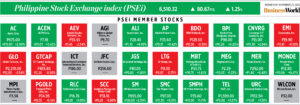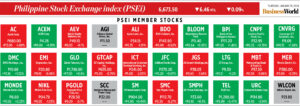Manufacturing output up by 2.4% in June on economic reopening

FACTORY output was up 2.4% year on year in June, rising for a second straight month as the economy reopened further with most mobility restrictions being lifted.
The growth was reflected in the preliminary result of the Monthly Integrated Survey of Selected Industries (MISSI) issued by the Philippine Statistics Authority (PSA) on Tuesday. The specific indicator tracking manufacturing output growth is known as the volume of production index (VoPI).
Growth accelerated from the revised 0.9% posted in May. The last decline was in April, when the indicator was revised to minus 0.2%.
In the six months to June, factory output rose 29.7% year on year.
In a phone interview, Philippine Chamber of Commerce and Industry Honorary Chairman Sergio R. Ortiz-Luis, Jr. said the recovery in manufacturing in June was due to the continued relaxation of quarantine alert levels, which govern the operating capacity of most establishments.
John Paolo R. Rivera, an economist at the Asian Institute of Management, said the reopening served to stimulate consumer demand.
Starting March, Metro Manila and other key regions were placed under Alert Level 1, the most permissive of the five quarantine alert settings.
However, Mr. Rivera said high inflation negatively affected manufacturing output due to the rising cost of raw materials.
“Currency depreciation also negatively affects manufacturers dependent on imported raw materials due to relatively lower purchasing power,” Mr. Rivera said in an e-mail.
Thirteen product categories drove VoPI higher in June, led by machinery and equipment except electrical, which grew 45.3% against 52.1% in May, followed by fabricated metal products, except machinery and equipment (31.4% from 30.7%), and wood, bamboo, cane, rattan articles, and related products (31% from 24.7%).
Nine categories reported contractions, led by print and reproduction of recorded media (minus 25.1% from minus 11.9% in May), basic metals (minus 8.5% from minus 26.1%), and basic pharmaceutical products and pharmaceutical preparations (minus 16.1% from minus 10%).
The manufacturing purchasing managers’ index (PMI) in June came in at 53.8, slowing down from the 54.1 reading in May. A reading of the PMI above 50 indicates an improvement in raw material orders which will be converted into goods. The PMI is considered a leading indicator for manufacturing activity because orders placed by purchasing managers reflect their best estimate of future demand levels.
Capacity utilization in manufacturing averaged 71.1% in June, higher than May’s 70.9%. Of the 22 product categories, 20 reported utilization rates of at least 60%.
Over the remainder of the year, manufacturing is expected to increase, though growth rates could ease with inflation and a weak currency posing downside risks, Mr. Rivera said.
Headline inflation in July was near a four-year high at 6.4% amid rising food and transport costs. Inflation accelerated from the 6.1% posted in June and the 3.7% reported a year earlier.
Inflation exceeded the central bank’s 2-4% target range for the year for a fourth consecutive month in July.
“(Manufacturing output) will increase,” said Mr. Ortiz-Luis, who also sits as the president of Philippine Exporters Confederation, Inc. “Basically, at the same rate, continuous ‘yun (The rise will be continuous). I think it is a trend already.” — Kyanna Angela Bulan




